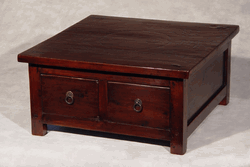When most people look at furniture, the last thing they
notice (if they notice it at all) is how the pieces are joined together. As
long as the furniture is sturdy, the owner is satisfied. If the chair sustains
the weight of the sitter, if the table is stable, if the cabinet stands firm
and reliable, it is enough. But how the elements are joined together is
actually a detail of craftsmanship.
What Asian Joinery Is Not
Asian furniture, especially those forms that are greatly
influenced by ancient Chinese methods, is notable for how the pieces are joined
together. There are three notable features in this type of joinery: first, no
glue is used at all for structural purposes; second, no pegs are used to hold
pieces together; third, no metal fasteners such as nails or screws are
used. You may wonder, “How is it held
together, then?”
The Art of Joinery in Asian Furniture
Folklore says that Chinese joinery has its roots in the work
of an ancient scholar turned woodworker, Lu Ban. But his works have nothing
about joinery in them, so no one knows for sure. He was very inventive, and
created many other things, and so the tradition holds. In any case, by the Tang
Dynasty Chinese joinery as it is known and practiced now was fully established,
and has not changed much at all.
The methods used for joining pieces in the construction of
furniture needed to last in harsh climates. Because most parts of China have
great extremes in humidity and temperature, the joints need to accommodate
swelling and shrinking of the wood, while keeping the whole piece of furniture
stable. It took some inventiveness to find a means that would hold the
materials together.
Frame and Panel Joinery
One method is called the “frame and panel” type. The frame
is held together with mitered, mortise-and-tenon joints. To secure the panel
part, around the upper, inside edge of the frame, a groove is cut, while the
panel has a matching tongue on its outer edge. The panel and frame are fitted
together, and transverse braces are placed in shallow dovetail housings in
order to give the thin panel support and keep it from warping.
Recessed Leg Joins
The “recessed-leg” form, used in many cabinets, tables,
chairs and stools, has the legs joined inside (hence “recessed”) the corners of
a mitered frame. This gives the upper surface an extension out over the leg.
The legs themselves slant outward toward the bottom, and are likely to be
connected to each other by variations of
stretchers or aprons. The top of each leg will be fitted to the underside of
the surface frame with double tenons.
Corner Leg Variation
For variation, there is also “corner-leg” construction.
Unlike the recessed leg, a corner leg is flush with the corners of the top
frame. This makes the top of the leg seem to be part of the upper surface.
However, these legs also come in a variety of shapes, from straight up-and-down
vertical to a c-shaped curve (similar to the European cabriole style). The feet
of these legs are often shaped like an animal claw, or hoof of a horse, or even
a simple scroll. And all held together without glue, nails or screws.
Check With Experts
If you are considering an Asian antique, you can always ask
an expert to help you examine these details in the piece you select. You can be
certain that the staff of Terra Nova Designs had offered you the best available
pieces, but you may still want to examine your choice carefully. You will find
fine furniture that has been specially selected for our customers in our shop.


